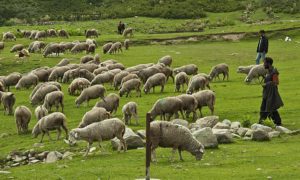How the quintessential Kashmiri hospitality became a hospice of history.
At a striking spot in the iconic Dal Lake unruffled by tourist footfall, the warm and gentle breeze of spring and the fusty smell of withered hydrophytes give a misty bliss.
The brassy sunrays descending on the heritage houseboats make the decorated decks shimmer with sightseeing glory. What’s unfolding in this part of the lake is the visual painting apparently set in mad chants and mystic melody.
Adding music to this quietude, are the boatmen’s pulsating peddles uplifting the lake tranquility. Wanderers in search of peace and solace tend to lose track of time gazing at the meditative milieu.
Anchored in this serene setting is a floating legacy of HB TEAL—the houseboat dating back to Kashmir’s Dogra Raj.
Back then it was owned by an English lady named Miss Devac who visited Kashmir with her husband in the early 1900’s.
The hunting hobby among those imperial British is what made them to visit the valley. They used to reside at Gulmarg during summers and inside houseboats on River Jhelum during winters.
The husband of Miss Devac, the then colonel of British Army, was fond of hunting. He had a habit of hanging the migratory bird named teal around his houseboat to show off his skills.
With such great passion for adventure and skill for hunting, he was known by the name of “Teal Man”. And whenever he was seen returning after a hunting session, people used to bawl in excitement: “Teal Man is coming!”
And that’s how this houseboat of Dal Lake got its name: H.B Teal.

[FPK Photos/Amir Bin Rafi.]
Decades later, the waned historical British grace is still glaring inside. The portrait of Miss Devac along with the artifacts—the paintings of wild birds, the 150-year-old furniture, the antique crockery—make this imperial era lodging a heritage house.
The deck decorated with Kashmir’s cultural and traditional showpieces creates a native feel and fixture.

[FPK Photos/Amir Bin Rafi.]
The entrance decorated with a pair of small little bells is made up of Paper Mache for a tempting approach.
The wooden showpieces placed at the corners of the entrance, the heavy Kashmiri carpets, almirahs, tables, walls and the large arched windows made of rich Deodar steal the glances.
The vibrancy of the houseboat now remains under the ownership of Abdul Ahad Shera, the third generation custodian.
In his sixties, Ahad is a dusky man sporting neatly checked shirt, with evenly parted hair dyed in light brown colour. Greeting his guests with a warm and kind gesture, he muses the innocence through his specky-eyes expressing gratitude and excitement.

[FPK Photos/Amir Bin Rafi.]
Ahad’s philosophical bent of mind makes him believe that the value of a human life lies within the innards of humanity.
“Rather than stressing on whether your child would become a doctor or engineer, parents should always focus on making their children a good human being,” remarked Ahad with a wary tenor and tone. “Humanity nowadays is nowhere to be seen and this should concern us all.”
As the thoughtful man sought shelter in the silence that his resounding remark created, a spectacular painting in the living area caught one’s attention.
Beautifully crafted on an oriental carpet, the painting, according to Ahad, portrayed a princess being taken away by her lover on a horseback while chased by her Muhafiz, her bodyguards.

[FPK Photos/Amir Bin Rafi.]
Next to the oriental glory was decades-old dining table owned by Miss Devac. It held a beautiful vase with some artificial flowers in the center covered with dust and crumbles of bread scattered on it.
Nearby, the picture of Miss Devac dangles as an exulting pale complexed profile. Her blue-gazed eyes and curly-blonde hair flash the hour of her belle.

[FPK Photos/Amir Bin Rafi.]
The legacy houseboat is a treasure-trove of centuries-old British crockery, with the label “George Jones & Sons-1709”. The vintage tag adds to its luxuriance and enhances the aesthetic value of the boat.
While showing some beautiful antiques from British era, Ahad said in a jutting look, “What we have is priceless and cannot be found anywhere.”

[FPK Photos/Amir Bin Rafi.]
Ahead of a long sunlit corridor, some old paintings of wild birds stuck to the wall have retained an aura of the hunting span.
The hallway leads one straight to the bedroom—decorated with Kashmiri handcrafted bedsheets along with an old dresser and some classic artwork.

[FPK Photos/Amir Bin Rafi.]
The washroom situated at the very end of the houseboat is covered in a light blue paint with white ruptured tiles.
Water drips from the white plastic tap alongside an old blue bathtub with a dingy mirror placed on the wall opposite to the door giving venerable vibes.

[FPK Photos/Amir Bin Rafi.]
Sitting back in the living area and talking about Miss Devac, Ahad recalled that during the period when slavery was common around the globe and people were supposed to be the servants of the superior race, oppressed and exploited by them in one way or the other, the British lady’s behavior and attitude towards her servants was exceptional.
Among her servants was a brave and loyal man—Shabaan Shera—Ahad’s grandfather who served Devac with a supreme sacrifice.

[FPK Photos/Amir Bin Rafi.]
Shabaan’s loyalty once rescued the British lady when her hut in Gulmarg rose up in flames.
Despite suffering from an ailing disease, Ahad’s grandfather saved the lady from getting caught into the mishap along with her dog whom Devac considered as her child.
Her Kashmiri servant’s loyalty deeply moved Devac. And to award his brave act, she gave him the keepsake—HB Teal.
“And keeping the same expression of adoration in mind, I want to preserve Miss Devac’s name with this monumental history and tell everyone what she meant to my family,” said Ahad.

[FPK Photos/Amir Bin Rafi.]
For a change, the houseboat owner stepped on the deck and drifted the discourse towards the hospitality of Kashmir.
“Our celebrated hospitality should not be confined to the tourists only but also to its natives,” he said, with a thoughtful gaze. “Koshur chuna haq thavan (Don’t the Kashmiris have this right).”
With that remark, Ahad was back to the British Raj when Shabaan couldn’t bare the suffering of his ailing disease and left the souvenir in the hands of his diligent son, Ahmad Shera.
Ahad’s father was then was a student at the missionary school Tyndale Biscoe of Srinagar. His intelligence and determination had made Miss Devac to sponsor his education.
Following his father’s demise, Ahmad Shera had to quit his studies and start taking care of the houseboat which was his family’s bread and butter.
The death of her servant had also forced Miss Devac to pack her bags and return to England—leaving no traces of junction behind her.
After that distressing departure, the Shera family never heard a word from her except a letter from an anonymous root calling on Ahmad Shera to come to England where she could handover her property to him.
But fate and circumstances didn’t allow him to travel to England and claim the property there.
Unable to contact Miss Devac after several failed attempts, Ahmad Shera came to know about her demise due to an ailing disease which brought nothing but distress to the family.

[FPK Photos/Amir Bin Rafi.]
Back home, the Sheras soon landed in a legal trouble as they were unable to prove the proprietorship claim to the ruling British officials.
The fear of losing the memento which meant everything to his family made Ahmad Shera’s wife who belonged to a well-off family sell her jewelry and some antique household items.
“Like then, we’re still fighting to safeguard this heritage house,” Ahad looking towards the rippling water of Dal Lake concluded.
“I’m happy HB.TEAL could survive the tests of the time to emerge as the floating legacy of Kashmir.”








